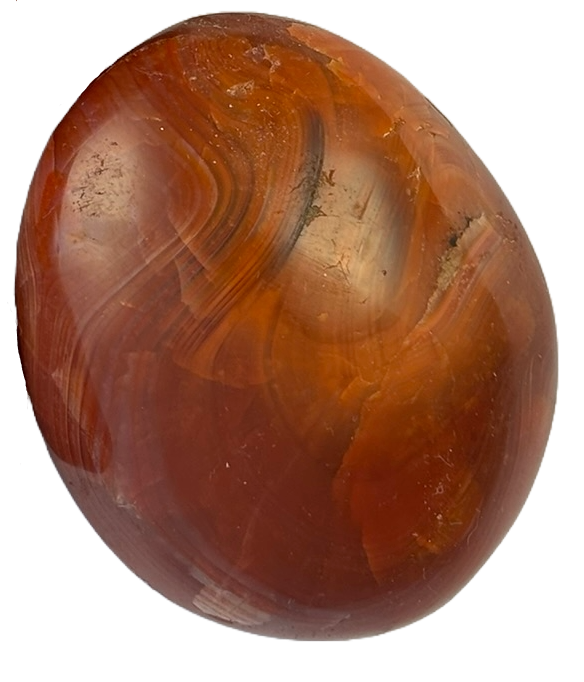
Carnelian s name originates from the Latin word carneus, meaning “flesh-coloured,” due to its rich red and orange hues. Historically, it has been referred to as Cornelian, particularly in older texts. Some cultures associate it with the term Sunset Stone, reflecting its warm, golden glow.
Composition, Physical Characteristics, and Varieties
Carnelian is a variety of Chalcedony, which itself belongs to the broader Quartz family. Its deep red, orange, and amber tones result from traces of iron oxide present during formation. Carnelian measures 7 on the Mohs hardness scale, making it durable enough for carving and jewellery.
Varieties of Carnelian include:
- Light Carnelian – pale orange hues with semi-translucent qualities.
- Deep Red Carnelian – intense, blood-red tones, often mistaken for Red Jasper.
- Banded Carnelian – featuring white or cream banding, sometimes blending with Agate.
Geographical Locations Where It Is Found
Major sources of Carnelian include India, Brazil, Madagascar, Germany, and the United States. Ancient deposits were also located in Egypt and Persia, where it was widely used for jewellery and amulets.
Archaeological and Significant Finds with Historical and Current Usage
Carnelian has been cherished for thousands of years. In Ancient Egypt, it was used for protective amulets and carved into seals, symbolising the power of life. Roman warriors wore Carnelian rings to strengthen courage, while Persian artisans embedded it into royal jewellery. Today, it remains a popular gemstone for rings, pendants, and talismans.
Interesting Facts
- Carnelian is one of the oldest gemstones used in human history, dating back over 4,000 years.
- In medieval times, it was believed to protect travellers from accidents and misfortune.
- Ancient Egyptians associated it with the goddess Isis, using it in burial practices to safeguard the soul.
Folklore, Superstition, Legends, and Tales
Carnelian has long been linked to protection, passion, and vitality. Legend holds that this fiery stone could revive the spirit, empowering warriors before battle. In Renaissance Europe, Carnelian was believed to dispel illusions and strengthen the voice, helping scholars and orators speak with confidence.
Mystical Healing Properties, Astrology, and Zodiac Associations
Carnelian is associated with strength, creativity, and motivation. Many believe it boosts confidence, passion, and endurance, making it ideal for those seeking personal empowerment. Astrologically, Carnelian aligns with Aries, Leo, and Virgo:
- Aries – enhances boldness and courage.
- Leo – fuels creativity and self-expression.
- Virgo – encourages decisiveness and clarity.
Chakra System Connections
Carnelian resonates strongly with the Sacral Chakra, igniting creativity and sensuality. It also connects with the Root Chakra, providing grounding energy and boosting stamina.
Use as a Birthstone and for a Wedding Anniversary
Carnelian is an alternative birthstone for August, linked to Leo and Virgo. It is also a traditional gift for a 17th wedding anniversary, symbolising warmth and passion in a lasting relationship.
Crystals That Work Well with Carnelian and Those to Avoid
- Best Pairings:
- Tiger’s Eye – boosts courage and strength.
- Citrine – enhances motivation and abundance.
- Red Jasper – deepens grounding and endurance.
- Crystals to Avoid:
- Amethyst – its calming energy may dampen Carnelian’s fiery nature.
- Sodalite – while both enhance clarity, their energies may clash when used together.

Carnelian
Bold and energising, Carnelian ignites passion, creativity, and confidence. A stone of motivation and vitality, it empowers action and strengthens resolve.
